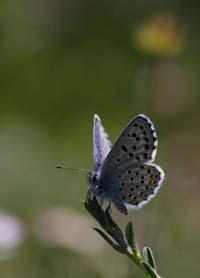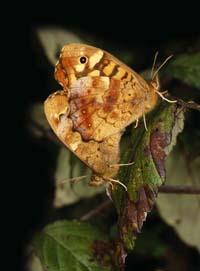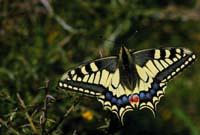Feast of butterflies

Although some species of butterflies are earlier, most are found in the middle of summer. They do not stand: the males chase the females or try to chase the others, while the females wait for the appearance of a male or seek a suitable plant to spawn the eggs.
Butterflies are born from eggs, yes, but it is not that elegant winged insect that leaves the egg, but the caterpillar. The caterpillar, unborn, begins to eat and feeds on insatiable hunger, grows and grows until the time of the crisis arrives.
The miracle occurs in the phase of chrysalis: the clumsy grass that was dragging becomes an elegant winged butterfly. To do this, the caterpillar seeks a safe place. Many butterflies of the day hang hidden among the leaves, while those of the night hang underground. The caterpillar collects the whole body with a fluid and forms a cover that gives protection. And it is that in the next days or months the butterfly will be there, without capacity to move to another side.
Within the chrysalis, in secret, there is a radical change. The internal organs of the caterpillar dissolve to form new ones, since the digestive system, for example, must adapt to new foods, from the mouth to the anus. The caterpillar was lush, but the butterfly that is about to be born will have as main source of food the pollen of the flowers. On the other hand, it develops legs and wings, developing a body with three differentiated parts, while unlike the caterpillar, the adult butterfly has head, chest and abdomen.

Once the transformation is finished, the butterfly breaks the chrysalis and leaves outside. Now its main goal is to find a friend to reproduce.
Butterfly in love
Some species of butterflies take hours or days to be ready for reproduction, but others reproduce as soon as they leave the chrysalis. Normally the males are the first to leave the chrysalis, hence the females. If a male feels a female about to leave the chrysalis, she sometimes stays in wait: she will cover her before the female leaves and starts flying.
In some species, however, the female does not need males for reproduction: they are partenogenetic species. This is the case of some butterflies of the Psychidae family, in the German area. The butterflies of Euskal Herria of the same species are not partenogenetic, the females reproduce with the males; in some way, as they approach from Germany appear also the males, so in they are found the partenogenetic females and the females needed of males.
In general, males and females are different, that is, there is sexual dimorphism. Females are usually somewhat larger and males usually have more intense colors. They also differ in attitudes, since the male usually goes in search of females, is quite territorialist and, although it does not have a very fixed territory, it is where it is, tries to scare the males that surround it.

To detect the female of the same species, the male observes the pheromones. The male easily smells of the special and attractive molecules emitted by the female through antennas. Males of some species are very sensitive and are able to detect even a female kilometers or a half kilometers away. But not only females, also males secrete pheromones. Once the female is found, she will have to accept it, and in it they also have to see the pheromones of the male. The female observes the pheromones of the male to decide if she likes.
For the macho-female attraction to occur, the key is on pheromones. They also command in attitude of many other animals, but the butterflies occupy a special place in the history of the investigation of pheromones, since the first pheromone they isolated was that of a butterfly, that of the female of the silk ( Bombyx mori ).
Feromona supports male butterflies, but, in addition, she does everything she can to attract the female: she teaches her elegant flight, she tries to emphasize. The male cuts the female. And once the female appears ready to cover, they look for an appropriate place.
Elegant, even on deck
Mating is a very critical moment: the two butterflies join each other and, in case of the appearance of a predator, they run a serious danger because they have trouble flying. In this case, smaller species have the advantage of being relatively alive, while larger species can hardly escape together. For this reason, they choose preferably hidden places like matorrales. Therefore, it is no surprise that the covers of large butterflies are the most difficult to observe.

The coating of butterflies usually occurs with each of them looking to one side, forming a beautiful symmetry. This occurs with the rays of the day. However, the nocturnal species, usually nocturnal and of brown colors, can be found sometimes faced. Interlaced, the male fertilizes the female through small abdominal movements.
The sexual organs of the butterflies are very complex. They are very special organs, since there is always a species characteristic of the species and within a same species from one subspecies to another. Therefore, subspecies that cannot be separated at first glance are classified according to the physiology of sexual organs.
This study consists of the death of the butterfly, its drying and the introduction of the final part of its abdomen in an adequate solution and microscopic observation of the sexual organs of the butterfly. This study is debatable from the point of view of the conservation of butterflies, especially when the objective is not the classification of a new research or subspecies, that is, by mere collecting.
According to lovers of butterflies, collecting has hurt butterflies. It must be taken into account that many species are in danger, and in the collections not only the most common butterflies are collected, but also the butterflies of rare species are shown; moreover, especially the butterflies of rare species interest collectors, or the rare specimens within a species, such as the ginandromorphs, which are the butterflies that characterize both sexes: characteristics of male and another of female.

Optionally, it is much more exciting to see the butterflies nailed in a shop window, gathering dust than to see on their site, that is, the flowers dancing in the fields. We have said that this is a good time to enjoy the festive summer atmosphere in the fields, mountains and forests. Yes, the feast is not forever; as the winter approaches, the butterflies will be clear, and only a few will last until the next spring. But remember, in winter there are also butterflies; they do not fly, they are hidden, most in the form of a hatch. But next year they will wake up again when they notice the warmth of the sun and the song of the kilkers, and the party will begin again.





